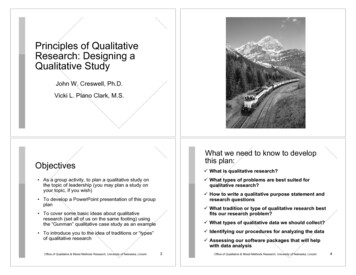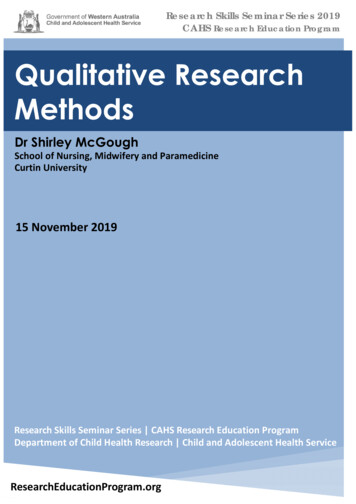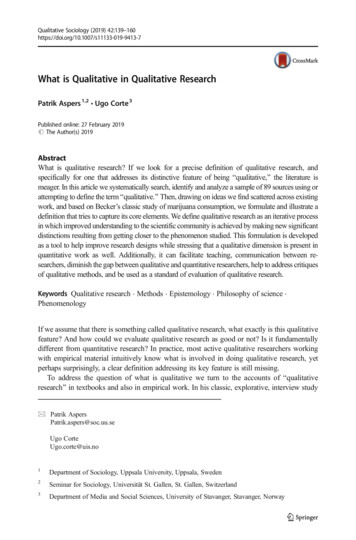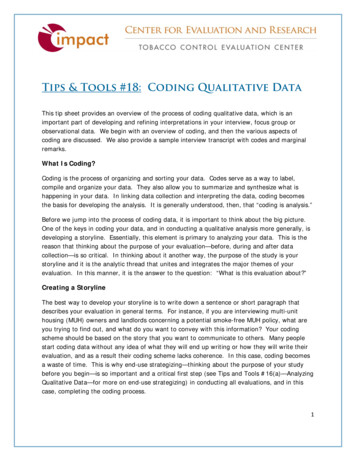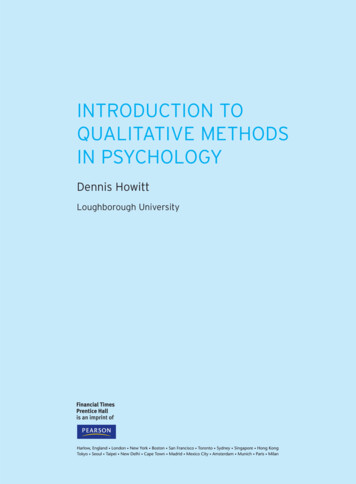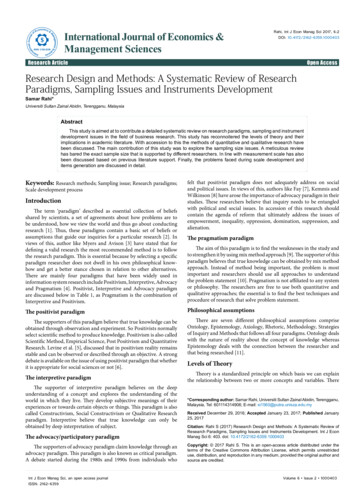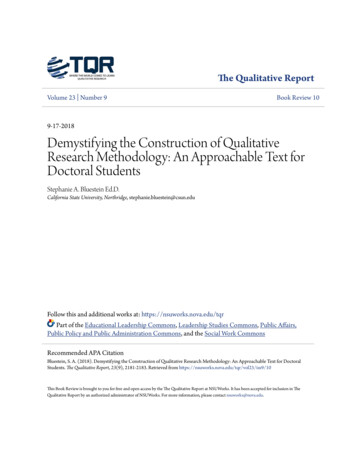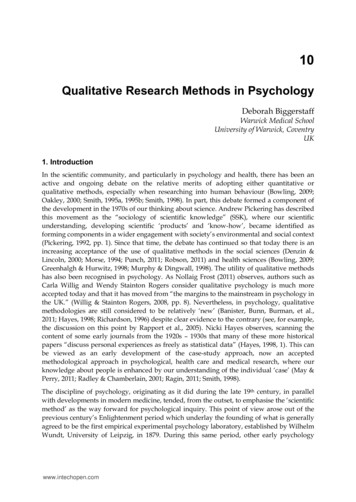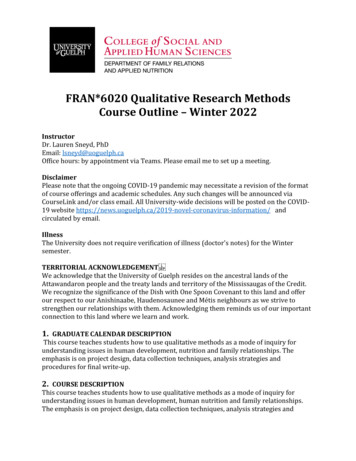
Transcription
FRAN*6020 Qualitative Research MethodsCourse Outline – Winter 2022InstructorDr. Lauren Sneyd, PhDEmail: lsneyd@uoguelph.caOffice hours: by appointment via Teams. Please email me to set up a meeting.DisclaimerPlease note that the ongoing COVID-19 pandemic may necessitate a revision of the formatof course offerings and academic schedules. Any such changes will be announced viaCourseLink and/or class email. All University-wide decisions will be posted on the COVID19 website formation/ andcirculated by email.IllnessThe University does not require verification of illness (doctor's notes) for the Wintersemester.TERRITORIAL ACKNOWLEDGEMENTWe acknowledge that the University of Guelph resides on the ancestral lands of theAttawandaron people and the treaty lands and territory of the Mississaugas of the Credit.We recognize the significance of the Dish with One Spoon Covenant to this land and offerour respect to our Anishinaabe, Haudenosaunee and Métis neighbours as we strive tostrengthen our relationships with them. Acknowledging them reminds us of our importantconnection to this land where we learn and work.1. GRADUATE CALENDAR DESCRIPTIONThis course teaches students how to use qualitative methods as a mode of inquiry forunderstanding issues in human development, nutrition and family relationships. Theemphasis is on project design, data collection techniques, analysis strategies andprocedures for final write-up.2. COURSE DESCRIPTIONThis course teaches students how to use qualitative methods as a mode of inquiry forunderstanding issues in human development, human nutrition and family relationships.The emphasis is on project design, data collection techniques, analysis strategies and
procedures for final write-up. Students will be introduced to the key components ofqualitative research methodologies and learn to differentiate between data sources andtheoretical approaches, along with gaining practical experience and training. Students willdiscuss applications to family relations, applied nutrition, health research and the use ofIndigenous methodologies.LEARNING OUTCOMESBy the end of the course it is expected that students should be able to: Identify and explain the approaches to qualitative research and how they apply tovarious disciplines of inquiry Practice using a qualitative research method Effectively design, collect and analyze qualitative data Critically assess ethical issues related to specific qualitative research methods andworking with certain population groups Explain positionality or reflexivity in qualitative research Identify and critically evaluate the strengths and weaknesses of qualitative researchdesigns in the literature Assess the quality or rigour of qualitative research Assess the advantages and disadvantages of the qualitative methodologies profiledas part of this course3. TIMETABLELecture: Thursdays 8:30-11:50amLocation: Via Teams. Please follow the calendar invite. MACS 3314. LEARNING RESOURCESRequired Resource(s):Readings will be assigned throughout the term and are listed below as part of the classschedule and available via Courselink. These articles are also required for class discussionsand engagement and should be read prior to class. A participation mark of 10% will reflectknowledge of the readings, class attendance and participation in the class discussion.Recommended Resource(s):Gaudet, S. and Robert D. 2018. A Journey through Qualitative Research: From design toreporting. London: Sage.Saldana J. and Omasta M. 2022. Qualitative Research: Analyzing Life. 2nd Edition. London:Sage.Walliman, N. 2020. Your Research Project: Designing, planning and getting started. London:Sage.Please also see list of additional resources below.5. TEACHING AND LEARNING ACTIVITIES/CLASS SCHEDULE
Week 1 Introduction to qualitative research design part 1 Positionality TheoryCarter, Stacy M. and Miles Little (2007). Justifying Method, Taking Action: Epistemologies,Methodologies and Methods in Qualitative Research. Qualitative Health Research 17(10):1316C28.Denzin, N., & Lincoln, Y. S. (2018). Introduction: The discipline and practice of qualitativeresearch. In N. Denzin, & Y.S. Lincoln (Eds.), The Sage handbook of qualitative research (5thed., pp. 1-26). London: Sage.Gaudet, S. and Robert D. (2018). Choosing Qualitative Inquiry. In A Journey ThroughQualitative Research: From Design to Reporting. Pg. 1-19. London: Sage.Holmes, A. (2020). Researcher Positionality - A Consideration of Its Influence and Place inQualitative Research - A New Researcher Guide.” Shanlax International Journal ofEducation, vol. 8, no. 4, 2020,pp. 1-10.Morse, J. M. (2015). Critical analysis of strategies for determining rigor in qualitativeinquiry. Qualitative Health Research, 25(9), 1212–1222.Saldana, J. and Omasta M. (2022). Introduction: Analyzing Life. In Qualitative Research:Analyzing Life 2nd Edition. Pg. 1-25. London: Sage.Optional (may be useful for the final assignment, start planning early):Watts, Michael 2001. The Holy Grail: In Pursuit of the Dissertation Proposal. Regents of theUniversity of California.Week 2 Research design part 2- Conceptual frameworks- EthicsDaly, K. (2007). Research Design: Constructing a research proposal. In Qualitative methodsfor family studies and human development (pp. 161-186) London: Sage.Mantzoukas, S. (2008). Facilitating research students in formulating qualitative researchquestions. Nurse Education Today, 28, 371–377.Maxwell, J. A. (2009). Designing a qualitative study. In L. Bickman, & D. J. Rog (Eds.), TheSAGE handbook of applied social research methods (pp. 214-253). London: Sage.
Starks, H., & Brown Trinidad, S. (2007). Choose your method: A comparison ofphenomenology, discourse analysis, and grounded theory. Qualitative Health Research,17(10), 1372-1380.Vainio, Annukka. 2012. ‘‘Beyond Research Ethics: Anonymity as ‘Ontology’, ‘Analysis’, and‘Independence’’. Qualitative Research 13 (6): 685-698.Tutorial for the TriCcouncil Policy Statement: Ethical Conduct for Research InvolvingHumans (TCPS). - didacticiel/University of California San Francisco. Qualitative Research Guide. Ethics,https://guides.ucsf.edu/c.php?g 100971&p 654838Week 3 Collecting data part 1- Choosing your method- Research process- TranscriptionGentles, S. J., Charles, C., Ploeg, J., & McKibbon, K. (2015). Sampling in qualitative research:Insights from an overview of the methods literature. The Qualitative Report, 20(11), 17721789.Gair, S. (2012). Feeling their stories: Contemplating empathy, insider/outsiderpositionings, and enriching qualitative research. Qualitative Health Research, 22(1), 134143. DOI: 10.1177/1049732311420580Karnieli-Miller, O., Strier, R., & Pessach, L. (2009). Power relations in qualitative research.Qualitative Health Research, 19(2), 279-289.Starks, H., & Brown Trinidad, S. (2007). Choose your method: A comparison ofphenomenology, discourse analysis, and grounded theory. Qualitative Health Research,17(10), 1372-1380.Week 4Tools In your toolkit: ObservationSecond half: Thematic analysisDeWalt, Kathleen M., and Billie R. DeWalt. 2011. "What is Participant Observation?Enhancing the Quality of Data Collection and Analysis." In Participant Observation: A Guidefor Fieldworkers, 10-15. Lanham: AltaMira Press. (available on courselink tab content)DeWalt, Kathleen M., and Billie R. DeWalt. 2011. "Chapter 8 - Informal Interviewing inParticipant Observation." In Participant Observation: A Guide for Fieldworkers, 137-178.Lanham: AltaMira Press.Kawulich, B.B. 2005. Participant Observation as a Data Collection Method. FQS.
/article/view/466/996Terry, G., Hayfield, N., Clarke, V., & Braun, V. (2017). Thematic analysis. In C. Willig, & W.Stainton-Rogers (Eds.), The Sage handbook of qualitative research in psychology (2nd ed.,pp. 17-37). London: Sage.Week 5Tools in your toolkit: Photo elicitation/photovoiceSecond half: Grounded theoryAllen, Louisa. 2011. "‘Picture this’: using photo-methods in research on sexualities andschooling." Qualitative Research 11 (5):487–504.Kelle, U. (2007). The development of categories: Different approaches in grounded theory.In A. Bryant, & K. Charmaz (Eds.), The Sage handbook of grounded theory (pp. 191-213).London: Sage.Liebenber, L. (2018). “Thinking Critically About Photovoice: Achieving Empowerment andSocial Change.” International Journal of Qualitative Methods. Volume 17: 1–9.Meo, Analía Inés. 2010. "Picturing Students’ Habitus: The Advantages and Limitations ofPhoto-Elicitation Interviewing in a Qualitative Study in the City of Buenos Aires."International Journal of Qualitative Methods 9 (2):149-171.Week 6Tools in your toolkit: InterviewSecond half: PhenomologyLaverty, S. M. (2003). Hermeneutic phenomenology and phenomenology: A comparison ofhistorical and methodological considerations. International Journal of Qualitative Research,2(3), 21-35.Manderson, Lenore, Elizabeth Bennett and Sari AndajaniCSutjahjo (2006). The SocialDynamics of the Interview: Age, Class and Gender. Qualitative Health Research p.1317C1334.Marta M. (2021). Interview Techniques. In Morin J., Olsson C. Atikcan, E. Research Methodsin the Social Sciences: An A-Z of Key Concepts. Oxford: OUP.Perara, Kaushalya. 2021. Interviewing academic elites: a discourse analysis of shiftingpower relations. Qualitative Research 21(2): 215-233.Week 7Tools in your toolkit: Interview II
Second half: Narrative analysisFeldman, M. and Almquist, J. 2015. Analyzing the Implicit in Stories. In Holstein J.A. andGuibrium, J. F. Varities of Narrative Analysis. London: Sage.Jones, Chelsea and Cheuk, Fiona. (2021). Something is happening: encountering silence indisability research. Qualitative Research Journal 21(1): 1-14.Katriel, Tamar. 2015. Analyzing the Social Life of Personal Experience Stories. In HolsteinJ.A. and Guibrium, J. F. Varieties of Narrative Analysis. London: Sage.Komil-Burley, O. (2021). Conducting Research in Authoritarian Bureaucracies: ResearcherPositionality, Access, Negotiation, Cooperation, Trepidation, and Avoiding the Influence ofthe Gatekeepers. International Journal of Qualitative Methods. 20:1-10.Optional:Bearman, M. Greenhll, J. Nestle, D. 2019. The power of simuation: A large-scale narrativeanalysis of learners’ experiences. Medical Education. 53: 369-379.Week 8Tools in your toolkit: Participatory methodsSecond half: Intersectional and Indigenous approaches to researchWhite, Darcy, and Rob Stephenson. 2014. "Using Community Mapping to UnderstandFamily Planning Behavior." Field Methods 26 (4):406-420.Castellano, M. B. (2004). Ethics of Aboriginal Research. Journal of Aboriginal Health, 1(1).Retrieved from http://www.naho.ca/jah/english/jah01 01/journal p98- 114.pdfLaVeaux D & Christopher S. (2009). Contextualizing CBPR: Key principles of CBPR meet theIndigenous research context. Pimatisiwin 7(1) s/2009/07/01Contents.pdfTobias, J.K., Richmond, C.A.M. & Luginaah I. (2013). CBPR with Indigenous Communities:Producing Respectful and Reciprocal Research. Journal of Empirical Research on HumanResearch Ethics, 8(2):129-140.Esposito, J. and Evans-Winters, V. 2021. (R)evolution of Qualitative Inquiry. In Introductionto Intersectional Qualitative Research. London: Sage.Week 9Tools in your toolkit: Content analysisSecond half: Discourse theory and analysisLocke, T. (2004). A Close up on Text. In. Critical Discourse Analysis. London: Continuum.
Locke, T. (2004). Analyzing a Print Text. In. Critical Discourse Analysis. London: Continuum.Nash, M. (2018). White pregnant bodies on the Australian beach: A visual discourseanalysis of family photographs. Journal of Gender Studies, 27(5), 589-606.Taylor, S. (2001). Locating and conducting discourse analytic research. In M. Wetherell, S.Taylor, & S. M. Yates (eds.), Discourse as data: A guide for analysis (pp. 5-48). London:Sage.(Available from: https://books.google.ca/books?hl en&lr &id R24kDQVefQC&oi fnd&pg PA1&dq Discourse as data: A guide for analysis&ots ICf7GEZK3G&sig KEVXY1N2yJqa2K-qg9jghKk1DI#v onepage&q&f false)Optional example: Sneyd, L. Q., Legwegoh, A., & Fraser, E. D. (2013) “Food riots: Mediaperspectives on the causes of food protest in Africa,” Food security 5(4), 485-497Week 10Tools in your toolkit: Data analysis and coding ISecond half: Working with data (thematic on- guide/analyze/analyze-qualitative-data/Richards, L. (2015). Part II Working with the Data. In Handling Qualitative Data: A Practicalguide. Sage: London. Pp. 83-125.Saldana, J. 2009. An Introduction to codes and coding. In The Coding Manual for QualitativeResearchers. Sage: London.Saldana, J. 2009. First Cycle Coding Methods. In The Coding Manual for QualitativeResearchers. Sage: London.Scotland, J. (2012). Exploring the philosophical underpinnings of research: Relatingontology and epistemology to the methodology and methods of the scientific, interpretive,and critical research paradigms. English Language Teaching, 5(9), 9- 16.Week 11Tools in your toolkit: Analyzing and coding data IISecond half: Writing and reporting, knowledge translationAntin, Tamar M. J., Norman A. Constantine, and Geoffrey Hunt. 2015. "ConflictingDiscourses in Qualitative Research: The Search for Divergent Data within Cases." FieldMethods 27 (3):211-222.Bennett, G and Nasreen Jessani. 2011. Introduction: The difference between a Paper and aPurpose(xxii) AND Knowledge Translation: An Introduction (pgs. 3-8) ANDCommunication Strategy (pgs. 103-130) IN The Knowledge Translation Toolkit. Sage:London.
Richards, L. (2015). Part III Making Sense of Your Data. Handling Qualitative Data: APractical guide. Sage: London. Pp. 141-205.Saldana, J. 2009. Second Cycle Coding Methods. In The Coding Manual for QualitativeResearchers. Sage: London.Week 12PresentationsEXTRA .sagepub.com.subzero.lib.uoguelph.caHELPFUL READINGS AND RESOURCESBazeley, P. (2007). Qualitative Data Analysis with NVivo. Thousand Oaks, CA: SagePublications Inc.Caretta, Martina Angela (2015). ‘‘Situated Knowledge in Cross- Cultural Research: ACollaborative Reflexive Analysis of Researcher, Assistant and Participant Subjectivities’’.Qualitative Research 15 (4): 489-505.Charmaz, K. (2006). Constructing grounded theory: A practical guide through qualitativeanalysis. London: Sage. (Chs. 3 & 5).Creswell, JW. (2013). Qualitative Inquiry and Research Design: Choosing Among FiveApproaches, 3rd Edition. Thousand Oaks, CA: Sage Publications Inc.Hein, S. F., & Austin, W. J. (2001). Empirical and hermeneutic approaches tophenomenological research in psychology: A comparison. Psychological Methods, 6(1), 317.Leavy, P. (2008). Method meets art: Arts-based research practice. New York: Guilford. (Chs.1-2).Mason, Jennifer. (2003). Qualitative Researching, 2nd Edition. London: Sage Publications.Richards, L. (2005). Handling Qualitative Data: A Practical Guide. Thousand Oaks, CA: SagePublications Inc.
Saldana, J. and Omasta M. (2022). Qualitative Research: Analyzing Life, 2nd Edition. London:Sage.Saldana, J. (2009). The Coding Manual for Qualitative Researchers. Thousand Oaks, CA: SagePublications Inc.Sneyd, Lauren ‘We eat what we have, not what we want’: The policy effects of food riotsand eating after the 2008 Crisis in Cameroon in Hossain, Naomi and Scott-Villiers, Patta(2017) Food Riots, Food Rights and the Politics of Provisions. Routledge. Chapter 5.Available here: visions-naomi-hossainpatta-scott-villiers?context ubx&refId 26048535-fa3e-4dc3-a0ab-2501208ede9eWertz, F. et al. 2011. Five Ways of Doing Qualitative Analysis: Phenomenological Psychology,Grounded Theory, Discourse Analysis, Narrative Research, and Intuitive Inquiry. New York:Guilford Press.OPTIONAL READINGS (Examples of Qualitative Research)Arts-Based AnalysisKnoblauch, H. (2012). Videography: Analysing video data as a ‘focused’ ethnographic andhermeneutical exercise. Qualitative Research 12 (3): 334-356.Luff, P. (2012). ‘Some technical challenges’ of video analysis: Social actions, objects,material realities and the problems of perspective. Qualitative Research, 12 (3): 255-279.Morris, R. (2008). ‘Cultural analysis through semiotics: Len Norris' cartoons on officialbilingualism. Canadian Review of Sociology/Revue canadienne de sociologie, 28 (2): 225254.Nash, M. (2013). Shapes of motherhood: Exploring postnatal body image throughphotographs. Journal of Gender Studies, 1-20.Discourse AnalysisBrooks, S. (2009). Radio food disorder: The conversational constitution of eating disordersin radio phone-ins. Journal of Community & Applied Social Psychology, 19, 360–373.Diorinou, M., & Tseliou, E. (2014). Studying circular questioning “in situ”: Discourseanalysis of a first systemic family therapy session. Journal of Marital and Family Therapy,40, 106– 121.Petrassi, D. (2012). ‘For me, the children come first’: A discursive psychological analysis ofhow mothers construct fathers’ roles in childrearing and childcare. Feminism & Psychology,22, 518–527.
Sneijder, P., & te Molder, H. (2009). Normalizing ideological food choice and eatingpractices. Identity work in online discussions on veganism. Appetite 52, 621–630.Sutherland, O. A., Forbes, L., Hodgson, B., & McLaren, K. (2014). Digital actualizations ofgender and embodiment: Microanalysis of online pregnancy discourse. Women's StudiesInternational Forum, 47, 102–114.Wiggins, S., Potter, J., & Wildsmith, A. (2001). Eating your words: Discursive psychology andthe reconstruction of eating practices. Journal of Health Psychology, 6, 5–15.Ethical IssuesAldridge, J. (2014). Working with vulnerable groups in social research: dilemmas by defaultand design. Qualitative Research 14 (1): 112-130.Berger, R. (2013). Now I see it, now I don’t: Researcher’s position and reflexivity inqualitative research. Qualitative Research 15(2): 219-234.Knudson, S.K. (2015). Integrating the self and the spirit: Strategies for aligning qualitativeresearch teaching with Indigenous methods, methodologies, and epistemology. QualitativeSocial Research 16 (3).Grounded TheoryAllen, K. R., & Roberto, K. A. (2009). From sexism to sexy: Challenging young adults’ ageismabout older women’s sexuality. Sexuality Research & Social Policy, 6, 13-24.Bianchi CM, Huneau JF, Le Goff G, Verger EO, Mariotti F, Gurviez P. (2016). Concerns,attitudes, beliefs and information seeking practices with respect to nutrition-related issues:A qualitative study in French pregnant women. BMC Pregnancy and Childbirth, 16(1): 306.Charmaz, K. (2017). The power of constructivist grounded theory for critical inquiry.Qualitative Inquiry, 23(1), 34–45.Garcia-Romeu, Albert. (2015). ‘Self-transcendent experience: A grounded theory study.’’Qualitative Research 15 (5): 633-654.Haselschwerdt, M. L., Hardesty, J. L., & Hans, J. D. (2011). Custody evaluators’ beliefs aboutdomestic violence allegations during divorce: Feminist and family violence perspectives.Journal of Interpersonal Violence, 26, 1694–1719.Kushner, K. E., & Harrison, M. J. (2011). Finding a balance: Toward a substantive theory ofemployed mothers’ personal and family health decision making. Journal of Holistic Nursing,29, 7-17.
Sorensen, P., & Coopera N. J. (2010). Reshaping the family man: A grounded theory study ofthe meaning of grandfatherhood. The Journal of Men’s Studies, 18, 117-136. Weaver, K.,Wuest, J., & Ciliska, D. (2005).Indigenous Research MethodologiesDrawson, A. S. , Toombs, E. , Mushquash, C. J. (2017). Indigenous Research Methods: ASystematic Review. The International Indigenous Policy Journal, 8(2). Retrieved from:https://ir.lib.uwo.ca/iipj/vol8/iss2/5Kovach, M. (2009). Indigenous methodologies: Characteristics, Conversations, and Contexts.Toronto, University of Toronto Press, Scholarly Publishing Division.McGregor D & Restoule JP. (2018). Indigenous Research: Theories, Practices andRelationships. Toronto: Canadian Scholar’s Press.Smith, L. T. (2021). Decolonizing Methodologies. 3rd Edition Dunedin: University of OtagoPress. 4b52faff0001578d24Wilson, S. (2009). Research is Ceremony. Halifax: Fernwood.Participatory ResearchGoeman D., King, J., & Koch S. (2016). Developing of a model of dementia support andpathway for culturally and linguistically diverse communities using co-creation andparticipatory action research. BMJ Open, doi:10.1136/bmjopen-2016-013064.Mundel, E., & Chapman, G. E. (2010). A decolonizing approach to health promotion inCanada: the case of the Urban Aboriginal Community Kitchen Garden Project. HealthPromotion International, 25(2), 166-173.White, J.W., Yuan, N.P., Cook, S.L. et al. (2013). Ethnic minority women’s experiences withintimate partner violence: Using community-based participatory research to ask the rightquestions. Sex Roles, 69: 226.Phenomenological AnalysisFord, K., & Turner, deS. (2001). Stories seldom told: Paediatric nurses' experiences ofcaring for hospitalized children with special needs and their families. Journal of AdvancedNursing, 33, 288-295.Eatough, V., & Smith, J. A. (2017). Interpretive phenomenological analysis. In C. Willig, & W.Stainton-Rogers (Eds.), The Sage handbook of qualitative research in psychology (2nd ed.,pp. 193-211). London: Sage.
Lucero, N. M. (2014). ‘It's not about place, it's about what's inside’: American Indian womennegotiating cultural connectedness and identity in urban spaces. Women's StudiesInternational Forum, 42, 9-18.Merrill, E., & Grassley, J. (2008). Women’s stories of their experiences as overweightpatients. Journal of Advanced Nursing, 64, 139–146.Millings, E. (2010). The role and influence of the father on his ‘child’ in biological and nonbiological relationships: Part Two – Introduction and research findings – An interpretativephenomenological analysis study. Counselling Psychology Quarterly, 23, 177-188.6. ASSESSMENT DETAILSAssignmentsResearcher positionalitystatementDeveloping a researchpurpose and questionGroup research methodsactivityFinal presentationFinal paperClass participationDue dates28 January 2022to the dropbox11 February 2022Value15%Sessions 5-11Please sign up during thefirst class7 April 2022Last session22 April 2022to the dropboxThroughout25%15%10%25%10%CONTRIBUTIONS AND ASSIGNMENTSResearcher positionality statement (15%)A 3-page (double-spaced, 12-point font) paper that describes your ontological andepistemological positioning as a researcher. The use of class readings as references isencouraged (for example, Holmes 2020), along with new literature to support your point ofview. All references need to be cited accurately using APA style.Also see: s-fb52ec0f4e17Research purpose and questions assignment (15%)Each student will develop a research purpose and questions of interest to them that willform the foundation for the final paper. The paper should be approximately 5 pages(double-spaced, 12-point font) and include a brief introduction of the importance of thetopic, rationale for the research, overall purpose and questions to be answered. Currentliterature to support your proposed study should also be included and cited accuratelyusing a reference list not included in the 5 page limit.
Exploring tools in your toolkit: Group research methods practice/activity andfacilitation (25%)Students will divide into groups of 2/3 according to research method interests and choosea week to facilitate from our class schedule. The groups will sign up for a week we arecovering the method and theme in class. Each group will research and design a classexercise for the first half of the seminar that will assist the class in further understanding orpracticing a particular method profiled. The second half will be about engaging themethodological approach. Each group will facilitate this activity with the class on Teams(remember we can form breakout rooms for smaller groups to practice a method or have adiscussion). Groups will have a meeting with Dr. Sneyd prior to their facilitation to discusstheir approach to planning and organizing the seminar.A short report per group should also be handed in the same day that consists of a 5-6 pagesummary and reflection of the activity. Any resources or sources of literature used as partof the activity design should also be attached to the report. Resources for the activity areavailabe from (please login with your UofG guelph.ca/videoQuestions to consider for discussion:Flexibility of research method and application: How can the research method be appliedand used? What skills are to be developed? What are the benefits? What are thedrawbacks? Troubleshooting? Flexibility? Ways of justifying the method? Reliability?Data: What are we aiming to collect? How does the data answer the research question?Who are the participants? How much data? When is saturation reached?Analysis: Tools? Revisiting the research question. Developing themes. Rigerousness?These questions are to be used to inspire and engage discussion. Please add to the list!Final paper (25%)Based on the research purpose and questions identified in the second assignment, studentswill develop and write up their methodology for approaching the research study in theform of a research proposal. A specific qualitative methodology (theoretical andmethodological approach) should be outlined and rationalized as to why the methodologyfits with the purpose and research questions to be answered. The following must beincluded: title, introduction, rationale/objectives/background research,methodology/approach, ethics protocol, participants, research design, data collection tools(such as interview guides to be included as appendices), recruitment procedures forparticipants as well as dissemination plans for the research in the form of a knowledgetranslation plan. The paper should be 10-12 pages in length (double-spaced, 12- pointfont), not including reference list and appendices.Presentation of final paper (10%)
The purpose of the assignment is for students to reflect on and discuss their research idea.The presentation is also a time for students to discuss how particular methods will be usedto answer their research question. The presentation should: 1) State your ProblemStatement, Research Question and 2 sub-questions (these must be questions that can beaddressed qualitatively). 2) State your research objectives: what do you hope to achievethrough this research? 3) Discuss your methodological approach. 4) Why this topic isimportant to you/timely and important to society (rationalization). You can see yourcolleagues’ presentations as a learning experience. Listening carefully to your colleagues’presentations will give you some ideas of the limits and possibilities in qualitative research.The presentations will be during our final class.Class participation (10%)Your voice, insight and presence in the class are important for your learning with the groupand will also be evaluated. Attendance is a must, along with active engagement in smallgroups and classroom conversations. Participation marks are not simply allocated to thosestudents who talk the most. Quality of input and demonstrated listening skills are alsoimportant methods of engagement. Learning from each other is an important skill todevelop in graduate school.7. COURSE STATEMENTSCourse Website:There is a course website at http://courselink.uoguelph.ca. All components of this coursewill be housed on the CourseLink site including this course outline, assignments, and linksto further resources. Your assignments will be submitted through the Dropbox function.Marks and feedback will also be released on the site. Please familiarize yourself with thiswebsite as soon as possible and visit it regularly throughout the semester.Late Assignments:Late assignments will be accepted up to 5 days following the due date and will receive apenalty of 10% per day EXCEPT under documented grounds for compassionateconsideration. Assignments submitted more than one week late without documentedgrounds will receive a grade of zero. If you are going to hand an assignment in late, youmust contact your course instructor to inform them when you will be submitting yourassignment.Receipt of Grades:After you receive a grade on CourseLink, please review your feedback. Any inquiry ordispute over the grade must be made within two weeks from the date they are posted. Ifyou fail to protest any grade during this time limit, changes to the grade will not beconsidered.Turnitin Software:
In this course, your instructor will be using Turnitin, integrated with the CourseLinkDropbox tool, to detect possible plagiarism, unauthorized collaboration or copying as partof the ongoing efforts to maintain academic integrity at the University of Guelph.All submitted assignments will be included as source documents in the Turnitin.comreference database solely for the purpose of detecting plagiarism of such papers. Use of theTurnitin.com service is subject to the Usage Policy posted on the Turnitin.com site.A major benefit of using Turnitin is that students will be able to educate and empowerthemselves in preventing academic misconduct. In this course, you may screen your ownassignments through Turnitin as many times as you wish before the due date. You will beable to see and print reports that show you exactly where you have properly andimproperly referenced the outside sources and materials in your assignment.8. UNIVERSITY STATEMENTSE-mail communication:As per university regulations, all students are required to check their uogu
Practice using a qualitative research method Effectively design, collect and analyze qualitative data Critically assess ethical issues related to specific qualitative research methods and working with certain population groups Explain positionality or reflexivity in qualitative research
